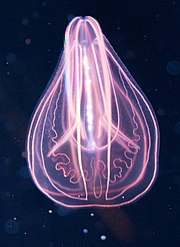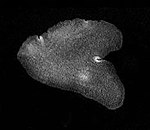Radiata
The radiate (Radiata ), coelenterate or coelenterate (Coelenterata ) They are a paraphyletic taxon historically used to group the most primitive eumetazoan animals, usually in opposition to those belonging to Bilateria, that is, emphasizing the presence of radiate symmetry instead of bilateral symmetry in the adult. They formed an ancient phylum of animals that included mainly the cnidarians and the ctenophores. There is unanimity that these two groups represent separate phyla and it is doubtful whether they are directly related. The old name coelenterates is also used by some authors, who use it as a synonym for Cnidaria.
The use of the characteristics of radiated symmetry, especially pentaradiated symmetry, in taxonomy and systematics has its drawbacks. There are many evolutionary convergences in animals at any level on the phylogenetic scale: for example, echinoderms, which have pentaradiate symmetry, do not belong to the Radiata group; in fact, its larva has bilateral symmetry.
For taxonomic systems that reject paraphyletic groups, Radiata or Coelenterata is considered an obsolete taxon.
Terminology and history
Coelenterata comes from the ancient Greek κοῖλος (koilos=“hollow”) and ἔντερον (enteron = guts, intestines) alluding to the digestive cavity with a single opening. Radiata (Linnaeus, 1758) comes from the Latin radio “to shine”, alluding to the radiated morphology or around a center. Both Coelenterata and Radiata may include or exclude Porifera depending on classification systems (see Diploblasta).
Georges Cuvier defined Radiata in 1817 to group cnidarians and ctenophores. Thomas Cavalier-Smith redefined Radiata in 1983 as a subkingdom that included the phyla Myxozoa, Placozoa, Cnidaria and Ctenophora.
In contrast, Lynn Margulis's classification into five kingdoms only included Cnidaria and Ctenophora in the radiates; the defining element here, in addition to symmetry, is the number of embryonic leaves: it includes only diblastic animals, that is, with endoderm and ectoderm, and excludes those considered monoblastic, such as sponges, although there is no agreement on this point.
Features
There are surface features that are common; many cnidarians, ctenophores and placozoans are usually very soft, gelatinous, globose, transparent and with a large liquid content. Cnidarians and ctenophores share some primitive characteristics, such as their diblastic organization (they only have two embryonic leaves, ectoderm and endoderm) and the absence of an anus in the digestive system, which is sac-shaped; however, ctenophores have two anal pores in the end opposite the mouth. They are considered to have radial symmetry, however, the ctenophores have a symmetry that could be considered rotational biradial.
On the other hand the differences are marked; On the one hand, the cnidarians have two vital forms, the polyp and the medusa, in addition the cnidarians have stinging cells, while the ctenophores have colloblasts, cells that produce a sticky substance that is used to catch their prey. Placozoans are highly simplified and amoeboid.
Radiata, as a paraphyletic group, can be considered an evolutionary degree within animal evolution between primitive sponges and bilateral animals, the latter considered the most evolved. In accordance with this perspective, a comparison can be made between the large groups of animals with the following table:
| Porifera | Celentérès | Bilateria | ||
|---|---|---|---|---|
| Cnidaria | Ctenophora | |||
| Symmetry | Asymmetric or radial | Radial | Birradial | Bilateral |
| Habitat | Bentonic | Pelagic and benthic | All habitats | |
| Specialized cell | Coanocito | Cnidoblasto | Coloblasto | (does not apply) |
| Gaster | No. | Yes. | Yes. | |
| Key cellular layers | Two: Pinacoderm and Coanodermo | Two: ectodermo and endodermo | Three: ectodermo, mesodermo and endodermo | |
| Area between layers | Mesohilo gelatinous with many cells | Gelatinous jellyfish with few cells | (does not apply) | |
| Cellular cohesion | Cell adhesion cells | Intercellular connection and basal membranes | ||
| External cells can be inserted and changed functions | Yes. | No. | No. | |
| Sensory bodies | No. | Yes. | Yes. | |
| Nervous system | No. | Yeah, simple. | Yes, complex | |
| Circulatory system, urinary and digestive organs | No. | No. | Yes, in Nephrozoa | |
| muscles | No. | Mostly at epithelial level | Mostly tissue with myocytes (muscular fiber) | |
Classification
Taking into account the system of Whittaker and Margulis (1978) as well as the current subgroups, it is summarized as follows:
Subkingdom Eumetazoa
- Rama Radiata (P)
- Superfilo Coelenterata (P)
- Filo Cnidaria
- Anthozoa subfilo (hearts, anemones and sea feathers)
- subfilo Medusozoa (lipo-medusas)
- Endocnidozoa subfilo (endoparasites)
- Filo Ctenophora
- class Tentaculata
- Nude class
- Filo Placozoa
- Filo Cnidaria
- Superfilo Coelenterata (P)
- Rama Bilateria
Phylogenetic relationships
The diblastic structure and the presence of a single opening and cavity led us to believe that cnidarians and ctenophores were related. There is no other data to show that both groups share a common ancestor. Therefore, today there is general agreement that the similarity between Ctenophora and Cnidaria (the jellyfish form) is due to evolutionary convergence due to the fact that both are adapted to pelagic life. Benthic ctenophores do not resemble polyps at all. Ctenophores lack the metagenic cycle and cnidoblasts characteristic of cnidarians, and instead do have a colloblast. The following possible relationships are proposed (2018):
| Animalia |
| ||||||||||||||||||||||||||||||||||||||||||
Contenido relacionado
Kingdom (biology)
X fragile syndrome
Tragopogon pratensis



